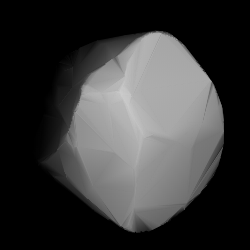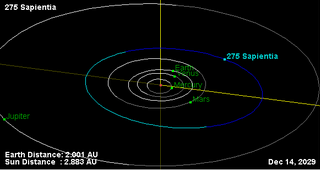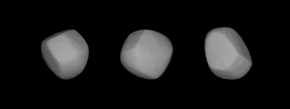
54 Alexandra is a carbonaceous asteroid from the intermediate asteroid belt, approximately 155 kilometers in diameter. It was discovered by German-French astronomer Hermann Goldschmidt on 10 September 1858, and named after the German explorer Alexander von Humboldt; it was the first asteroid to be named after a male.

56 Melete is a large and dark main belt asteroid. It is a rather unusual P-type asteroid, probably composed of organic rich silicates, carbon and anhydrous silicates, with possible internal water ice. The asteroid orbits the Sun with a period of 4.18 years.

110 Lydia is a large belt asteroid with an M-type spectrum, and thus may be metallic in composition, consisting primarily of nickel-iron. It was discovered by French astronomer Alphonse Borrelly on 19 April 1870 and was named for Lydia, the Asia Minor country populated by Phrygians. The Lydia family of asteroids is named after it.

124 Alkeste is a main-belt asteroid, and it is an S-type (silicaceous) in composition. C.H.F. Peters discovered the asteroid on August 23, 1872, from the observatory at Hamilton College, New York State. The name was chosen by Adelinde Weiss, wife of the astronomer Edmund Weiss, and refers to Alcestis, a woman in Greek mythology.

127 Johanna is a large, dark main-belt asteroid that was discovered by French astronomers Paul Henry and Prosper Henry on 5 November 1872, and is believed to be named after Joan of Arc. It is classified as a CX-type asteroid, indicating the spectrum shows properties of both a carbonaceous C-type asteroid and a metallic X-type asteroid.

154 Bertha is a main-belt asteroid. It was discovered by the French brothers Paul Henry and Prosper Henry on 4 November 1875, but the credit for the discovery was given to Prosper. It is probably named after Berthe Martin-Flammarion, sister of the astronomer Camille Flammarion.

170 Maria is a Main belt asteroid that was discovered by French astronomer Henri Joseph Perrotin on January 10, 1877. Its orbit was computed by Antonio Abetti, and the asteroid was named after his sister, Maria. This is the namesake of the Maria asteroid family; one of the first asteroid families to be identified by Japanese astronomer Kiyotsugu Hirayama in 1918.

176 Iduna is a large main-belt asteroid that was discovered by German-American astronomer Christian Heinrich Friedrich Peters on October 14, 1877, in Clinton, New York. It is named after Sällskapet Idun, a club in Stockholm that hosted an astronomical conference; Idun is also a Norse goddess. A G-type asteroid, it has a composition similar to that of the largest main-belt asteroid, 1 Ceres.

191 Kolga is a large, dark main-belt asteroid that was discovered by German-American astronomer C. H. F. Peters on September 30, 1878, in Clinton, New York. It is named after Kólga, the daughter of Ægir in Norse mythology.

273 Atropos is a typical Main belt asteroid that was discovered by Austrian astronomer Johann Palisa on 8 March 1888 in Vienna.

275 Sapientia is a very large Main belt asteroid that was discovered by Johann Palisa on 15 April 1888 in Vienna. It is classified as a C-type asteroid and is probably composed of carbonaceous material. It is named for the Roman personification of wisdom, Sapientia.

340 Eduarda is a main belt asteroid that was discovered by German astronomer Max Wolf on 25 September 1892 in Heidelberg. It was named after German banker and amateur astronomer Heinrich Eduard von Lade.
568 Cheruskia is a minor planet, specifically an asteroid orbiting in the asteroid belt that was discovered by German astronomer Paul Götz on 26 July 1905 from Heidelberg.

573 Recha is a minor planet, specifically an asteroid orbiting in the asteroid belt between Mars and Jupiter. The asteroid, discovered by German astronomer Max Wolf on September 19, 1905, was named after a character in Gotthold Ephraim Lessing's play Nathan the Wise and may have been inspired by the asteroid's provisional designation 1905 RC.

605 Juvisia is a minor planet, specifically an asteroid orbiting in the asteroid belt that was discovered 27 August 1906 in Heidelberg by German astronomer Max Wolf. It was named after the commune Juvisy-sur-Orge, France, where French astronomer Camille Flammarion had his observatory.
607 Jenny is a minor planet, specifically an asteroid orbiting in the asteroid belt that was discovered by German astronomer August Kopff on September 18, 1906.
687 Tinette is a minor planet, specifically an asteroid orbiting primarily in the asteroid belt. It was discovered by Austrian astronomer Johann Palisa on 16 August 1909 from Vienna and was given the preliminary designation 1909 HG.
7187 Isobe, provisional designation 1992 BW, is a likely binary Hungaria asteroid from the inner regions of the asteroid belt, approximately 5 kilometers in diameter. It was discovered on 30 January 1992, by American astronomer Eleanor Helin at Palomar Observatory in California, United States. It is named after Japanese astronomer Syuzo Isobe.
1951 Lick, provisional designation 1949 OA, is a rare-type asteroid and Mars-crosser, approximately 5.6 kilometers in diameter. It was discovered on 26 July 1949, by American astronomer Carl Wirtanen at Lick Observatory on the summit of Mount Hamilton, California, and named for American philanthropist James Lick.

4388 Jürgenstock, provisional designation 1964 VE, is a bright Phocaea asteroid from the inner regions of the asteroid belt, approximately 4.7 kilometers in diameter. It was discovered on 3 November 1964, by astronomers at Indiana University during the Indiana Asteroid Program at Goethe Link Observatory in Indiana, United States. The assumed S-type asteroid has a short rotation period of 2.8 hours and is rather spherical in shape. It was named for German-Venezuelan astronomer Jürgen Stock. In February 2019, the asteroid occulted the brightest star in the night sky, Sirius.















